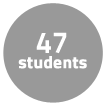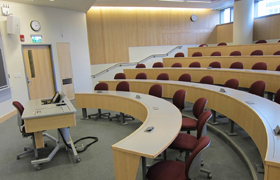Instructor Insights pages are part of the OCW Educator initiative, which seeks to enhance the value of OCW for educators.
Course Overview
This page focuses on the course 15.S07 GlobalHealth Lab as it was taught by Dr. Anjali Sastry in Spring 2013. This course is now offered under the permanent course number 15.233.
GlobalHealth Lab is a graduate course structured around both classroom learning and action-based field projects in which teams of students collaborate with host organizations to develop sustainable improvements that address real limitations to health care delivery. Students start by conducting research, developing topical briefings, and planning their fieldwork before they spend two weeks at the sites of their respective host organizations. When on site, students engage with the enterprise and the local community in carrying out their work plans. Upon returning, students are then asked to reflect on their experiences and lessons learned in the field to better define needs in global health delivery. Since its first offering in 2008, GlobalHealth Lab has seen over 40 such projects in sub-Saharan Africa and South Asia. The course is part of Action Learning at MIT Sloan, but is open to all interested MIT graduate students.
Course Outcomes
Course Goals for Students
Over the progression of the course, students should learn how to translate learning and research into action in a manner that is effective, rigorous, and beneficial on a global scale. Students often enter the course with the personal goal of applying their professional and educational background in a new and grassroots setting.
Possibilities for Further Study/Careers
Students in the course have often already determined a career path. Many, however, remain in contact with their host organizations and sit on some of the boards and committees.
If you want to do these intensive action learning projects, you have to develop an orientation toward both student learning and benefits to the partnering organizations.
—Dr. Anjali Sastry
In the following pages, Dr. Sastry describes various aspects of planning, teaching, and running 15.S07 GlobalHealth Lab.
- Course Goals and Measuring Success
- Pre-course Activities
- Collaboration with Partner Organizations
- Pre-trip Deliverables
- Post-trip Work
- Evolution of the Course
- Reflections and Advice
- Applications Beyond the Course
Curriculum Information
Prerequisites
No previous coursework required. However, interested students must undergo the application and interview process in the preceding fall.
Requirements Satisfied
Sloan Intensive Period (SIP) units
Offered
Every spring semester

Breakdown by Program
The students in this class come from a variety of programs, as the course is not restricted to Sloan School of Management:
- Masters students from Engineering disciplines
- MBAs and PhDs from Sloan School of Management
- PhDs from Health Sciences and Technology (HST) and Science, Technology, and Society (STS)
Typical Student Background
Students often have an orientation toward health sciences but are also knowledgeable in management, engineering, and science disciplines. Some display experience in mathematics, statistics, and operations research.
Enrollment Cap
The course usually runs with 40–50 participants with the logistics of the course as the limiting factor, and the students are selected through an application process that includes a written and interview portion. In recent years, up to 80 students have applied.
This course is offered during the spring semester, but accepted students are expected to initiate contact with their host organizations in the preceding December. Research carries through IAP, and students are required to work full-time for the two weeks that they spend on site. Students work through SIP for which they will receive two units in addition to the class’s 12 units. During an average week in the spring semester, students were expected to spend 12 hours on the course, roughly divided as follows:
In Class
- Two 1.5-hour lectures per week
- 16 class sessions in total, with additional mentor/team meetings
- Occasional hour-long lunch sessions for trip and project logistics
Out of Class
- Team meetings
- Readings in preparation for class
- Workplan and other project deliverables
- On-site fieldwork (full-time for two weeks)
Semester Breakdown
| WEEK | M | T | W | Th | F |
|---|---|---|---|---|---|
| 1 |  |  |  |  |  |
| 2 |  |  |  |  |  |
| 3 |  |  |  |  |  |
| 4 |  |  |  |  |  |
| 5 |  |  |  |  |  |
| 6 |  |  |  |  |  |
| 7 |  |  |  |  |  |
| 8 |  |  |  |  |  |
| 9 |  |  |  |  |  |
| 10 |  |  |  |  |  |
| 11 |  |  |  |  |  |
| 12 |  |  |  |  |  |
| 13 |  |  |  |  |  |
| 14 |  |  |  |  |  |
| 15 |  |  |  |  |  |
| 16 |  |  |  |  |  |
 No classes throughout MIT
No classes throughout MIT Class session
Class session Mentor / Team Meeting
Mentor / Team Meeting No class session scheduled
No class session scheduled On-site
On-site Lunch session
Lunch sessionLead Instructor (Dr. Anjali Sastry)
As the course instructor, Dr. Sastry performs the classroom teaching and the grading for the course. She leads the planning and running of the course with help from the faculty mentors and teaching assistant. The course instructor also mentors some of the student teams. She also leads the effort of recruiting, working with, and following up with host organizations.
Faculty Mentors
Because the course instructor does not have time to provide in-depth guidance for every team, other faculty members share this responsibility. The faculty mentor serves as a point person for their assigned team(s), and meets with the students every ten days or so for the bulk of the course. They check in to understand how each team is doing and what questions they have. While it is easy to focus on logistics such as housing, visas, and transportation, the mentors try instead to focus on the substance and progress of the project.
Teaching Assistant
The teaching assistant (TA) is usually an MBA student who has taken the course before or a PhD student who is enthusiastic about and committed to the course. The TA often works in the background, interacting with students and helping the course run smoothly. The TA serves as an additional channel of information on the students’ progress and challenges, and helps the teams stay on top of the constant work required by these complex projects.
MIT Staff and Community
In the first half of the course, there is a series of lunchtime gatherings that review logistics that are important, but cannot be covered during limited class time. Individuals from MIT and Sloan who specialize in these different domains come in to speak to the students. Topics vary from year to year but could include information pertaining to visa applications, travel medicine, legal issues, and even photography and videography.
For example, the session on travel medicine helps orient students toward not only the vaccinations that they need but also the medications they should travel with and the risks associated with traveling. There have also been “speed dating” style lunchtime sessions during which students meet briefly in succession two dozen experts who specialize in different issues such as IT, a given country, governance, and microfinance. Students are then connected to an expert–whether a grad student, staff member, faculty member, or alumnus–who can provide expertise relevant to the projects.
Past Students
Over the past several years, the course team has maintained a Wiki in which students can document their advice for future GlobalHealth Lab participants. The Wiki includes advice on everything such as, “bring along granola bars when traveling in this setting,” or “make sure to bring pens to give away,” or “don’t bring pens because everybody gives away pens.” This resource provides a communication from student to student, and offers a voice of experience from a different perspective.


 Room 1 of 2
Room 1 of 2 
